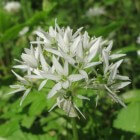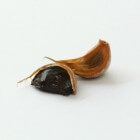Allium sativum, medisch wetenschappelijk samengevat
Allium sativum of knoflook is een bolgewas, behorend tot de Lelie-achtigen. De bol is samengesteld uit 5 tot 15 teentjes, omgeven door een papierachtig wit of paars omhulsel. De plant heeft tot 60 cm lange, platte bladeren en bloeit in de zomer met een wit-groene tot roze bolvormige bloeiwijze. Naaste familieleden zijn prei, bieslook en daslook, allemaal planten die min of meer dezelfde gezondheidswaarde hebben als knoflook.Inhoudsstoffen van knoflook
- Etherische olie ± 0,3 % met zwavel: mono, di-, tri- en polysulfiden. geur: 4,5,9-TRITHIADODECA-1,6,11-TRIEN-9-OXYDE
- Allicine , ontstaat bij aansnijden uit alliïne 0,2 % o.i.v. alliïnase (enzym)
- Thyocyanaatverbindingen
- Ajoen (= disulfide, ontstaat uit allicine omzettingen bij macereren in bvb olie: antithrombotisch)
- Enzymen (o.a. arginase, alliinase)
- Vitaminen B1, nicotinezuur, C (15 mg)
- Mineralen: Mg (36 mg), Ca (29 mg), Zn, Fe (1,5 mg), Mn, Co, Cu, Mo, Br (0,44 mg).
- Adenosine 56 mg/100 g (aggregatieremmend, anti-aritmica)
Algemene farmacologische werking van knoflook
- Cholesterolverlagend, Fibrinolyticum: Look remt het samenklitten van de bloedplaatjes (adenosine, allicine, ajoen) de bloedstollingstijd kan verlengen.
- Beïnvloedt de samenstelling van de bloedvetten, daling triglyceriden, daling LDL, stijging HDL. Invloed van knoflook op de vetstofwisseling (Dr. Lau)
- Bloeddrukverlagend: systolisch 8-33 mm Hg, diastolisch 4-20 mm Hg.
- Antibacterieel met breed spectrum o.a. tegen gram-positieve en gram-negatieve bacteriën
- Allicine in vitro bij verdunning 1/100.000 nog actief tegen stafylococcen, intestinale bacteriën en zelfs schimmels. (1 mg allicine komt overeen met 15 I.E. Penicilline)
- Anti-viraal (influenza-virus, preventief )
- Antimycotisch (schimmelwerend) o.a. tegen: Candida albicans, Histoplasma caps., Aspergillusstammen
- Tumorremmend: verschillende onderzoeken, tegengaan ontwikkeling borsttumoren bij muizen
- Bloedsuikerverlagend.
- Lichte invloed op schildklier: kleine dosis verhoogt activiteit, hoge dosis verlaagt activiteit.
- Antidotum ( bij nicotine-intoxicatie, bij loodintoxicatie) en leverbeschermend
- Algemeen tonicum: bevordert de zuurstofbenutting door de weefsels
Bijwerkingen: In zéér grote hoeveelheid (diervoeding) kan look bloedarmoede veroorzaken (15 gr/kg lichaamsgewicht) bij honden; bij paarden in Japan door het eten van bieslook. Contactdermatitis bij gevoelige personen. Verse knoflook kan maagirritatie veroorzaken.
Belangrijkste medische toepassingen
- aderverkalking,
- te hoog cholesterolgehalte
- virale infecties: griep, verkoudheid, Aids?
- ouderdomsdiabetes (preventie)
- haaruitval?
Bereidingswijzen van knoflook
- Verse knoflook: 2 tot 4 gr 2 maal daags.
- Infuu: 4 grams in 150ml water.
- Capsules: 600 to 900 mg daags.
- Standarizeerd allicin extract: 0.6-1.8g/daags.
- Tinctuur (1:5 in 45% alcohol): 2-4 ml 3 x daags
- Looksap: (BPC 1949) 2 to 4 ml.
- Looksiroop: (BPC) 2 tot 8 ml.
- en natuurlijk elke dag in de keuken: soep aioli, olie
Historisch gebruik van Allium sativum.
- Egypte: 2500 voor Chr.: Eerste vermeldingen, gebruikt bij de bouw der piramiden.
- Papyrus Ebers: 1550 voor Chr.
- Toet-Ank-Amon: 1338 voor Chr.: aanwezig in grafkamer.
- Hyppokrates: 400 voor Chr.: Corpus Hyppokrates.
- Galenus: Theriak, universeel geneesmiddel der boeren
- Petrus Nijlandt (1682) vermeldt: ‘Voor Tandt-pijn: Look in azijn
- Dioscorides: ‘Voor kwaad Zeer van ’t Hooft: Vermengt het sap met honing en bestrijkt er het hoofd mede ’.
- Dodonaeus: ‘Voor alderhande koud Vergift... Voor de Wormen der jonge kinderen: Siet de look in Soete-Melck’.
- Ravelingius: ‘Voor de Pest: Look, Stinkende gouwe en Wijnruit op witte wijn.
- Brunfelsus, Fuchius: ‘Voor zwaren Hoest: Neem het sap met varkensreuzel vermengt en bestrijkt er de palm van de voeten en polsaderen mee’.
Oudere wetenschappelijke onderzoeken
- Metropolitan Hospital New York - 1914: Onderzoek bij meer dan 1000 personen met TBC.
- Leclerc: Note sur l'emploie de l'Ail dans les affections des voies respiratoires. Union pharmaceutique - 1917.
- Leclerc: Histoire de l'Ail. Janus - 1919.
- Torotsev, Filatova - 1943: Emploi de phytoncides dans le traitement des plaies infectés.
- Erlikhman: Influence des antibiotiques de l'Ail (phytoncides) sur les transformations de la L.-tyrosine dans le tissu renal. Ukrain Biokhim Zt. 21/25 - 1949.
- Courmont, Morel, Perrot, Saulaville: Du pouvoir infertilisant des essences d'ail et de moutarde sur les cultures homogènes de bacille de Koch. C.R. Soc. Biol. 124/749-751.
- Ovansjans: Influence des phytoncides de l'Ail sur l'agent de la muscardine du vers à soie. Microbiologie USSR 22/61 - 1953
Oudere referenties
- Leclerc: L'Ail, préservative de la grippe. Paris médical dec. - 1918.
- Louper, Forestier, Hurrier: La teinture d'Ail dans un cas de gangrène pulmonaire. Bull. Soc. Méd. des Hôpitaux de Paris - 1921.
- Pouillard: L'Ail et son action sur la tension arterielle. Thèse, Paris - 1922.
- Guillon: Sur les proprietées hypotensives d'ail. Thèse de Paris - 1930.
- Lorand: L'Ail dans la prévention du cancer. Paris médical - 1933.
- Cavalito, Baillet: Allicin, the antibacterial principle of Allium sat. Am. Chem. Soc. 66 - 1950. Am. Chem. Soc. 1944/67 - 1952. Science 100/390 - 1944.
- Leclerc: Un traitement alliacé de la coqueluche. Presse médicale - 13 mars 1948.
- Petkov: On the action of garlic (A. sativum L.) on the bloodpressure. Sovremenna Medicina 1/5 - 1950.
- Petkov: Plants with hypotensive, antiatheromatous and coronarodilating action. Am. J. Chinese Med. 3/197 - 1979.
- Jain.: Effect of alc. extr. of garlic in athérosclerosis. Am. Journ. Clin. Nutr. 31/11/1982-1983
- Ariga et al.: Platelet Aggregation Inhibitor in Garlic. Lancet 150-151 - 1980.
- Bouillin: Garlic as platelet inhibitor. Letter to the editor. Lancet 776-777 - 1981.
- Hikino H. e.a.: Antihepatotoxic actions of A. sativum bulbs. Planta Med. 3/163 - 1986.
Recente referenties
- Ashraf R, Aamir K, Shaikh AR, et al. Effects of garlic on dyslipidemia in patients with type 2 diabetes mellitus. J Ayub Med Coll Abbottabad 2005 Jul-Sep;17(3):60-4.
- Bordia, A. et al. 1977. Effect of essential oil of onion and garlic on experimental atherosclerosis in rabbits. Atherosclerosis 26(3):379–386.
- Brewitt, B. and B. Lehmann. 1991. Lipidregulierung durch standardisierte Naturarzneimittel. Multizentrische Langzeitstudie an 1209 Patienten. Der Kassenarzt 5:47–55.
- Brosche, T. and D. Platt. 1990. Knoblauch als pflanzlicher lipidsenker. Neuere untersuchungen mit einem standardisierten knoblauchtrockenpulver-präparat [Garlic as phytogenic antilipemic agent. Recent studies with a standardized dry garlic powder substance]. Fortschr Med 108(36):703–706.
- Ernst, E., T. Weihmayr, A. Matrai. 1985. Garlic and blood lipids. Br Med J (Clin Res Ed) 291(6488):139.
- Fleischauer AT, Arab L. Garlic and cancer: a critical review of the epidemiologic literature. J Nutr 2001;131(3s):1032S-1040S.
- Gail MH, You WC. A factorial trial including garlic supplements assesses effect in reducing precancerous gastric lesions. J Nutr 2006 Mar;136(3 Suppl):813S-815S.
- Gardner CD, Lawson LD, Block E, et al. Effect of raw garlic vs commercial garlic supplements on plasma lipid concentrations in adults with moderate hypercholesterolemia: a randomized clinical trial. Arch Intern Med 2007 Feb 26;167(4):325-6.
- Fulder, S. 1989. Garlic and the prevention of cardiovascular disease. Cardiology in Practice 7:30–35.
- Gebhardt, R. 1991. Inhibition of cholesterol biosynthesis by a water-soluble garlic extract in primary cultures of rat hepatocytes. Arzneimforsch 41(8):800–804.
- ———. 1993. Multiple inhibitory effects of garlic extracts on cholesterol biosynthesis in hepatocytes. Lipids 28(7):613–619.
- Harenberg J., C. Giese, R. Zimmermann. 1988. Effect of dried garlic on blood coagulation, fibrinolysis, platelet aggregation and serum cholesterol levels in patients with hyperlipo- proteinemia. Artherosclerosis 74(3):247–249.
- Hassan HT. Ajoene (natural garlic compound): a new anti-leukaemia agent for AML therapy. Leuk Res 2004;28(7):667-671.
- Hajheydari Z, Jamshidi M, Akbari J, et al. Combination of topical garlic gel and betamethasone valerate cream in the treatment of localized alopecia areata: a double-blind randomized controlled study. Indian J Dermatol Venereol Leprol 2007 Jan-Feb;73(1):29-32.
- Heinle, H. and E. Betz. 1994. Effects of dietary garlic supplementation in a rat model of atherosclerosis. Arzneimforsch 44(5):614–617.
- Iciek M, Kwiecień I, Włodek L Biological properties of garlic and garlic-derived organosulfur compounds. [JOURNAL ARTICLE]
- Environ Mol Mutagen 2009 Feb. Over het effect van knoflook bij kanker.
- Jain, R.C. and D.B. Konar. 1978. Effect of garlic oil in experimental cholesterol atherosclerosis. Atherosclerosis 29(2):125–129.
- Josling P. Preventing the common cold with a garlic supplement: a double-blind, placebo-controlled survey. Adv Ther 2001;18(4):189-193.
- Jung, F. and H. Kiesewetter. 1991. Einfluss einer fettbelastung auf plasmalipide und kapilläre hautdurchblutung unter knoblauch. Med Welt 42:14–17.
- Kiesewetter, H. et al. 1991. Effect of garlic on thrombocyte aggregation, micro-circulation and other risk factors. Int J Clin Pharmacol Ther Toxicol 29(4):151–155.
- McNulty CA, Wilson MP, Havinga W, et al. A pilot study to determine the effectiveness of garlic oil capsules in the treatment of dyspeptic patients with Helicobacter pylori. Helicobacter 2001;6(3):249-253.
© 2009 - 2024 Herborist, het auteursrecht van dit artikel ligt bij de infoteur. Zonder toestemming is vermenigvuldiging verboden. Per 2021 gaat InfoNu verder als archief, artikelen worden nog maar beperkt geactualiseerd.
 Daslook, goed voor de bloedvatenKnoflook kent iedereen, zowel zijn geneeskrachtige als zijn culinaire kwaliteitenworden algemeen gewaardeerd. Een andere…
Daslook, goed voor de bloedvatenKnoflook kent iedereen, zowel zijn geneeskrachtige als zijn culinaire kwaliteitenworden algemeen gewaardeerd. Een andere…
 Zwarte knoflookNaast de gewone knoflook is er ook zwarte knoflook op de markt. Het bijzondere van deze zwarte knoflook: het is geurloos…
Zwarte knoflookNaast de gewone knoflook is er ook zwarte knoflook op de markt. Het bijzondere van deze zwarte knoflook: het is geurloos…
 Knoflook en wrattenIedereen heeft er wel eens last van gehad: een wratje. Er zijn veel middeltjes op de markt om wratten te behandelen, maa…
Knoflook en wrattenIedereen heeft er wel eens last van gehad: een wratje. Er zijn veel middeltjes op de markt om wratten te behandelen, maa…
 Vingerafdrukken en dactyloscopieTegenwoordig zijn er veel populaire misdaadprogramma's en serieus op de televisie. In deze series lossen de crime scene…
Vingerafdrukken en dactyloscopieTegenwoordig zijn er veel populaire misdaadprogramma's en serieus op de televisie. In deze series lossen de crime scene…
Gerelateerde artikelen
Knoflook tegen vermoeidheidKnoflook (Allium sativum) is een kruid dat in veel landen voornamelijk als voedingsmiddel wordt gebruikt, toch is dat ge…
Boze mensen maken betere beslissingenLange tijd werd boosheid gezien als een emotie die nadelige effecten op beslissingen en informatieverwerking heeft. Er w…
Bronnen en referenties
- Cursusboek Herboristen Opleiding. Monografie Allium sativum. Maurice Godefridi. www.everyoneweb.com/herbarius Professional's Handbook of Complementary & Alternative Medicines. Fetrow en Avila.
Herborist (762 artikelen)
Gepubliceerd: 05-04-2009
Rubriek: Wetenschap
Subrubriek: Diversen
Bronnen en referenties: 1
Gepubliceerd: 05-04-2009
Rubriek: Wetenschap
Subrubriek: Diversen
Bronnen en referenties: 1
Per 2021 gaat InfoNu verder als archief. Het grote aanbod van artikelen blijft beschikbaar maar er worden geen nieuwe artikelen meer gepubliceerd en nog maar beperkt geactualiseerd, daardoor kunnen artikelen op bepaalde punten verouderd zijn. Reacties plaatsen bij artikelen is niet meer mogelijk.